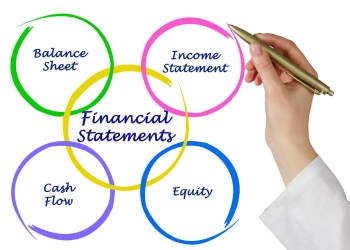
Financial statements are Written documents describing a company's operations and financial results. Government authorities, accounting companies, etc., frequently audit financial accounts for accuracy and tax, financing, or investment purposes. The balance sheet, statement of earnings, statement of cash flow, and summary of changes in equity are the primary financial statements for a for-profit company. Nonprofit organizations use a comparable but distinct set of financial statements.
The three main financial statement reports are the statement of assets, liabilities, and report of business cash flows. This essay will look at the importance of Basic Financial Statements, analyze their components, and guide how people might learn this important subject.
The Financial Statements' Importance
The Basic Financial Statements are the foundation of financial reporting for any firm, small or large, or even your accounts. These statements are useful tools for decision-making since they give a quick overview of an organization's performance and financial health. The main categories of fundamental financial statements are as follows:
The balance sheets
An entity's financial situation at a particular point in time is shown in a balance sheet, often called an assessment of financial condition. It lists an entity's liabilities, equity (the ownership interest), and assets (what the entity possesses).
Statement of Income
The income statement, often known as the statement of profit or loss, shows the earnings and outlays for a given time for an organization. It shows if the organization turned a profit or lost money during that period.
Cash Flow Statement
A cash flow statement displays the inflow and outflow of cash and cash equivalents for a certain period. It aids in evaluating an entity's liquidity and cash management and is divided into operating, investing, and financing activities.
A cash flow statement example
A section of ExxonMobil Corporation's fiscal year 2021 cash flow statement as of December 31, 2021, is shown below. The three sections of the cash flow account and their outcomes are visible.
There was $48 billion in positive cash flow from operating activities.
During the period, investing activities resulted in negative cash flow or cash outflows of -$10.2 billion. The majority of cash outflows were attributed to additions to property, plant, and equipment, indicating an investment in new fixed assets by the corporation.
During the period, financing operations resulted in a negative cash flow or outflows of -$35.4 billion. The bulk of the cash withdrawals were from dividend payments and reductions in short-term debt.
Basic Financial Statement Components
To comprehend each of these Basic Financial Statements components, let's take a closer look at each one:
The balance sheet
Assets: These are the resources that the organization possesses, such as money, property, inventory, and accounts receivable.
Liabilities: These are debts, such as credit cards, accounts payable, and accumulated expenses, that the organization owes to outside parties.
Equity: Following the deduction of liabilities, equity is the remaining interest in the entity's assets. It is the ownership or shareholder's claim to the business's assets.
Statement of Income
Revenues: The money received from selling goods or services is revenue.
Expenses: The costs incurred during the revenue-generating process are referred to as expenses.
Net Income (Profit or Loss): This is the amount that remains after deducting all costs from all income.
Cash Flow Statement
Operating Activities: These are the cash flows from the company's main lines of business.
Investing Activities: The cash flows from purchasing securities, real estate, or equipment.
Financing Activities: Cash flows from borrowing money from other sources, such as issuing shares or taking out loans.
The Value of Financial Knowledge
Financial literacy is more than just knowing how to stick to a budget and save money. It entails understanding basic financial ideas that people need to manage several facets of their financial lives, like borrowing, investing, and future planning. To get you started, consider these fundamental financial concepts:
1. earnings
Managing your finances begins with knowing what your income is. Income comprises your pay and any additional funds from sources such as dividends, rental income, and profits from side gigs.
2. Charges
Everything you spend on, including groceries, entertainment, and travel, is considered an expense. Knowing what you spend each month and year will help you manage your money better.
3. Setting a budget
The foundation of financial literacy is the creation and observance of a budget. You may allocate your income to pay bills, save money, and make investments for the future using a budget.
4. Equities
Savings is reserving a portion of your money for unforeseen expenses and crises. Certificates of deposit, savings accounts, and other methods of investing and saving can help achieve this.
5. Danger and Gain
There are hazards associated with investing, and it's important to comprehend how risk and possible return are related. Investments with larger returns frequently come with higher risks, and striking this balance is crucial when making financial decisions.
Knowing the Fundamental Financial Statements
Knowledge of these claims can help students become financially literate and make wise decisions. To help you understand basic financial accounts, consider the following advice:
Examine Real-World Examples: To understand how these statements are used in the real world, examine the financial reports of real companies.
Acquire Knowledge of Financial Ratios: When analysing financial accounts, ratios like the debt-to-equity ratio, liquidity ratio, or return on investment can be quite helpful.
Put Interpretation Into Practice: Gain the ability to see patterns and warning signs in financial statements by learning to read between the lines.
Use Online Resources: Financial statement analysis tutorials and courses are free on several educational websites and platforms.
Seek Guidance: Be bold and approach mentors, instructors, or business experts for advice or clarity.
Conclusion
Understanding Basic Financial Statements is important because it will help you both in your studies and your job. These declarations help with financial planning and decision-making by offering information about an entity's financial situation. Whether you're handling a company's money or yourself, you'll be more adept at navigating the financial scene if you can grasp these fundamental concepts.
Comments (0)
Categories
Recent posts


Why Is School So Boring? Get The Answer ...
10 Oct 2023
How Long Does It Take To Get a Business ...
10 Oct 2023
Comprehending Basic Financial ...
14 Nov 2023



